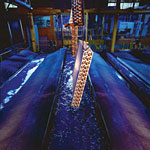
"We started using e-coat when it first came out," said Mark Lien, sales and marketing manager for Outokumpu Heatcraft, Grenada, Miss. "It was introduced to the HVACR industry at the AHR Expo that was held in Philadelphia in 1998.
"Mike Powell from AST ElectroFin had been telling us for a year that they had a new process coming out that would revolutionize coil coating," Lien said. "We were already an occasional user of their traditional coatings and when they introduced it at the show, we agreed to try it."
Outokumpu Heatcraft arranged some tests and was pleased by the results. Today, virtually all of their coils are coated by e-coat.
"There are several reasons the process is superior to dipping or spraying," said Mike Powell, sales and marketing manager at AST ElectroFin, Louisville, Ky. "Traditional methods cannot guarantee complete coverage, especially with the new fin designs. There's nothing to drive the coating into the small openings and recesses. And, with dipping or spraying, the thickness of the coating will vary from two to four mils.
"With e-coat," he continued, "the coating is attracted to the metal surface one molecule at a time and gets into the tiniest openings, so every metallic surface gets coated. It also results in uniform thickness. The result is a coating consistently one mil thick."
"One of the advantages of the e-coat process is that the coating is physically flexible," said John Armstrong, senior applications engineer for heat transfer products at McQuay International, Minneapolis. "The fins on our coils are different than most. They have little slots cut into them for better heat exchange.
"It's very difficult to get a coating into [coils] by dipping or spraying," he said. "But the e-coat gives us 100-percent coating and the flexibility of the coating permits us to comb out damaged fins without cracking or flaking. The coating itself is only one mil thick as opposed to two to four mils for other methods, and that translates into less air pressure drop and a heat transfer loss of only one percent, as opposed to two to four percent for other methods."
Don't Forget Your Coat
According to AST ElectroFin, with the e-coat process, a coil's original heat transfer rates are maintained longer over the extended life of the coil (as compared to an uncoated coil in the same environment)."The coating application process is done in five steps," said Powell. "First, the coil is put into a heated cleaning bath to remove oils and soil. The coil is then rinsed with tap water, then a second rinse with deionized water.
"The fourth step is the e-coat process. The coil is put into a bath filled with the water-based epoxy coating and a charge opposite that of the coating is applied. The coating molecules are attracted to the metal of the coil, completely covering all surfaces to a thickness of one mil. Because they share the same polarity, the molecules adhering to the surface repel other molecules, so there is no additional buildup.
"After the coating is applied," Powell said, "the coil goes into another deionized water bath and then into a 400 degree F oven, where the molecules cross link to form a hard yet flexible, corrosion-resistant surface."
A development engineer for another manufacturer stated that e-coating is "the only process I've heard of that consistently gets between the fins. And it must be faster to do because we're getting really fast turnaround times."
"We use e-coat almost exclusively," said Chuck Dawson, general manager of operations at Carrier Commercial Refrigeration in Scottsboro, Ala. "The only way we use other coatings is if the customer specifies them. One reason is that we have a lot of applications on the sea coast. This technology stands up against salt better than any I've tried. It's cut way down on warranty work."
Lien agreed. "Electro deposition has virtually eliminated [cracks and peeling]. Soon after we started using e-coating, we noticed a drop in warranty claims that has stayed consistent over the years."
The e-coat process may be an old technology, but it has found some modern applications in the HVACR arena.
Sine is a freelance writer specializing in the HVAC marketplace. He can be reached at jack.sine@verizon.net or 845-838-1466.
Publication date: 09/06/2004

Report Abusive Comment